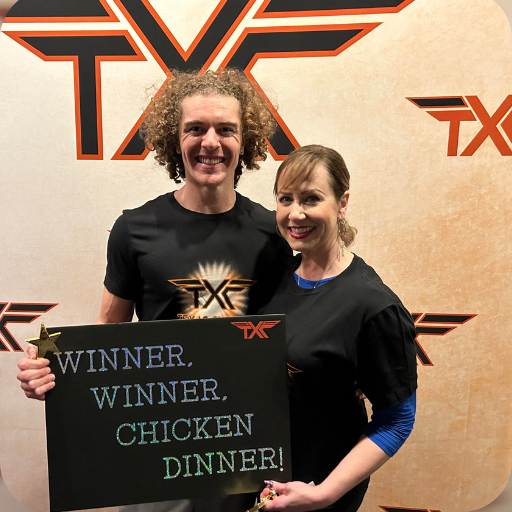Competitions and showcases provide a platform for dancers to show off their skills, challenge themselves, and connect with others in a fun, and safe environment.

Why Host Competitions and Showcases?
Hosting competitions and showcases isn’t just about crowning winners or putting on a performance—it’s about building community and encouraging dancers to push their boundaries. Here are some of the key benefits:
Motivation and Skill Development: Preparing for a competition or showcase pushes dancers to work harder, improve their skills, and focus on their technique. It’s a great motivator that encourages practice and growth.
Building Confidence: Performing in front of an audience or competing in a friendly environment helps dancers build confidence. It’s an opportunity to step outside their comfort zone and feel proud of their progress.
Strengthening Community Bonds: Competitions and showcases unite people, creating a shared experience that strengthens the community. It’s not just about the dancers on stage—it’s also about the friends, family, and fellow dancers who come to support them.
Attracting New Members: Well-publicized events can attract new dancers curious about WCS. Seeing a live performance or competition can be the spark that gets someone interested in joining your community.
Planning Your Event
Define the Event Type and Format
Decide whether you’re hosting a competition, a showcase, or a combination of both. Each format offers something different:
Competitions: These events are usually structured with categories based on skill level (beginner, intermediate, advanced) and style (Jack and Jill, Strictly Swing, etc.). Competitions foster friendly rivalry and encourage dancers to test their skills against others.
Showcases: A showcase is more performance-based, allowing dancers or groups to put together choreographed routines. This format is less about competition and more about creativity, expression, and entertaining the audience.
Mixed Events: Consider hosting an event that combines both elements—a competition segment followed by showcases. This can provide a well-rounded experience catering to competitive dancers and those who enjoy performing.
Set Clear Rules and Guidelines
Establishing clear rules and guidelines for your event helps set expectations and ensures everything runs fairly. Key areas to cover include:
Entry Requirements: Define who can enter based on skill level, dance experience, or partnership. Make sure these criteria are clear to avoid confusion or disputes.
Judging Criteria: If you’re hosting a competition, outline the judging criteria so dancers know what they’re being evaluated on. Common criteria include technique, timing, creativity, musicality, and overall performance.
Safety Guidelines: Include safety guidelines to ensure that routines are appropriate for the venue and don’t pose a risk to the dancers or audience. Encourage safe lifts, tricks, and movements.
Recruit Judges and Instructors
For competitions, having qualified judges is important to maintaining credibility and ensuring fair evaluations. If possible, bring in judges with experience in competitions or a solid background in the dance community.
Choose Reputable Judges: Select judges known for their expertise, fairness, and ability to provide constructive feedback. If your budget allows, consider inviting guest judges who can add prestige to your event.
Instructor Workshops: Pair your event with workshops taught by the judges or guest instructors. This adds extra value for participants, allowing them to learn from the experts and improve their skills.
Plan the Event Logistics
Organizing the logistical details is essential for a smooth event. This includes securing a venue, managing registrations, and setting up the schedule.
Select the Right Venue: Choose a venue that fits the size and vibe of your event. Ensure it has a good dance floor, ample space for spectators, and the necessary amenities (like sound equipment and restrooms).
Manage Registrations: Use online platforms like Eventbrite or a dedicated registration system to handle entries, ticket sales, and payments. Keep the process straightforward to encourage participation.
Create a Schedule: Draft a detailed schedule that includes check-in times, warm-ups, competition rounds, showcase performances, and breaks. Share the schedule with participants beforehand so they know what to expect.
Promote Your Event
Get the word out about your competition or showcase through all available channels. The more excitement you build, the better the turnout and overall energy of the event.
Social Media Promotion: Use Facebook, Instagram, TikTok, and other platforms to share event details, highlight competitors or performers, and build anticipation. Create an event page with all the necessary information and encourage participants to share it.
Engage Your Community: Promote the event at your regular classes and social dances. Use flyers, announcements, and word-of-mouth to generate buzz among your current members.
Local Outreach: Contact local dance studios, schools, and other WCS communities. Invite them to participate or attend and offer group discounts to encourage attendance.
Creating a Positive and Supportive Environment
Competitions and showcases should be fun, inspiring, and supportive. Here’s how to create an environment where everyone feels welcome and encouraged:
Emphasize Friendly Competition
While competition can be motivating, keeping the atmosphere positive and stress-free is important. Emphasize that the main goal is to have fun, learn, and celebrate dance.
Encourage Good Sportsmanship: Remind participants to support each other, cheer on their fellow dancers, and respect the judges’ decisions. Foster a culture of encouragement rather than rivalry.
Provide Constructive Feedback: If possible, have judges provide feedback or offer brief coaching sessions after the competition. This adds value for the dancers and helps them grow, regardless of their placement.
Recognize All Participants
Not everyone will win, but every dancer deserves recognition for their efforts. To keep the mood uplifting, celebrate all participants, not just the winners.
Participation Awards: Consider giving out small tokens of appreciation, like certificates, medals, or even fun titles (like “Best Smile” or “Most Creative Routine”). This shows appreciation for everyone’s hard work.
Highlight Performances: Share photos and videos of the event on social media, tagging participants and highlighting standout moments. This keeps the excitement going and gives dancers something to be proud of.
Keep the Energy High
Everything, from the music to the emcee, should contribute to an exciting atmosphere. Choose upbeat tracks, keep the audience engaged, and ensure your event flows smoothly.
Engaging Emcee: A good emcee can keep the crowd excited and maintain the event’s pace. Choose someone energetic, knowledgeable about WCS, and good at connecting with the audience.
Audience Participation: Get the audience involved with activities like “audience choice” awards, cheering sections, or a quick dance break between rounds. This keeps the crowd engaged and adds to the overall fun.
Final Thoughts on Hosting Competitions and Showcases
Hosting competitions and showcases is a fantastic way to bring excitement, challenge, and community spirit to your group. These events are more than just a chance to perform or compete—they’re an opportunity to celebrate the joy of dance, push boundaries, and strengthen the bonds within your community. So start planning, get those dancers on stage, and let the magic of WCS shine!
